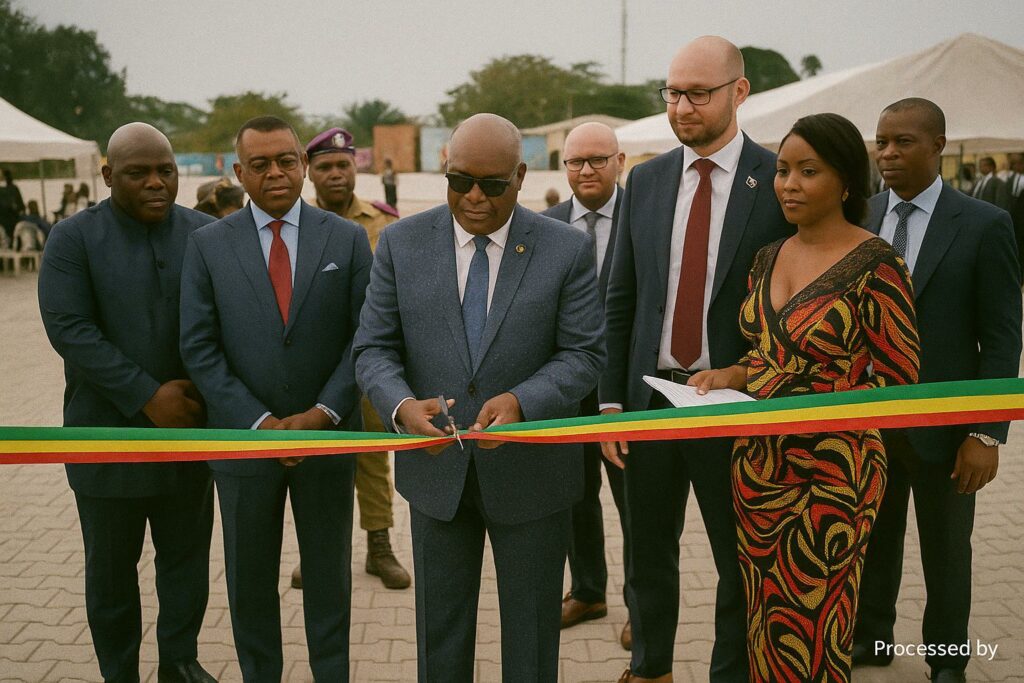Strategic Warehousing for Grid Stability
Few events in the technical life of a power network attract political symbolism. Yet the hand-over of two purpose-built warehouses to Energie Électrique du Congo (E2C) on 28 July in Brazzaville was staged with the ceremonial solemnity usually reserved for power-plant inaugurations. Standing among rows of freshly painted steel racks, Minister of Energy and Hydraulics Emile Ouosso saluted what he called “the quiet insurance policy of our transmission backbone,” a reference to the 2 000 m² of sheltered floor space now allocated exclusively to transformers, circuit breakers and gas-insulated components.
The facilities—one at Itatolo in the capital’s Djiri arrondissement and a twin structure at Mongo-Kamba II in Pointe-Noire—are designed to pre-position heavy equipment before a fault occurs. Engineers interviewed on site noted that the former Société Nationale d’Électricité often needed months to import a single autotransformer. “Every week of outage cost the national economy several hundred million CFA,” one senior technician recalled, pointing to the need for a paradigm shift from reactive to preventive logistics.
AFD–Congo Partnership and Funding Mechanism
The warehouses are the visible offspring of wider French-Congolese cooperation in the electricity sector. In July 2015 Brazzaville and the Agence Française de Développement signed a €70 million financing convention to underwrite the Priority Investment Plan of the then SNE, later restructured as E2C. According to AFD documentation consulted by the journal, the envelope blended a sovereign loan with a grant window, reserving almost one-third of the funds for network reliability (AFD portfolio note, 2022).
Executed over fifteen months by the local firm Central BTP, the civil-works contract absorbed slightly more than two billion CFA francs, a figure Ministry officials insist remained within the original budget despite pandemic-related supply shocks. The rest of the AFD line continues to support twenty-three additional sub-projects ranging from smart-grid studies to rural electrification audits, reflecting Paris’s emphasis on both hardware and institutional capacity.
Regional Impact on Transmission Resilience
Geographically, the logic is straightforward. The Itatolo depot will serve the Brazzaville, Pool, Plateau, Cuvette-Ouest and Sangha regions, together representing over sixty percent of national demand. Mongo-Kamba II, for its part, will support the Kouilou, Pointe-Noire, Bouenza and Niari grids, zones where industrial consumption tied to oil and mining operations remains intense.
Energy economists at Marien Ngouabi University argue that warehousing of critical spares can shave restoration time after a major fault from an average of 21 days to fewer than seven, thereby reducing unserved energy by up to 40 GWh annually (university policy brief, 2023). In a country where the hydrological cycle already imposes seasonal volatility, such gains translate into greater macroeconomic predictability.
Industrial Local Content and Workforce
Beyond reliability metrics, the project delivered tangible industrial spin-offs. Central BTP employed 120 workers at peak, ninety percent of them Congolese nationals trained in handling SF6-insulated apparatus and in warehouse management software compliant with ISO 55001 asset-management standards. For many apprentices, the experience offers a springboard into Congo’s nascent maintenance-service market, which the African Development Bank values at US$40 million annually (AfDB sector report, 2023).
Minister Ouosso emphasised that operational expenditure will likewise favour local enterprises, as E2C intends to outsource periodic inspection, fire-safety systems and climate-control maintenance under contracts reserved for firms registered in Brazzaville or Pointe-Noire. That approach dovetails with the government’s 2022 Industrialisation Acceleration Plan, which prioritises knowledge transfer in high-value technical services.
Diplomatic Dimensions of Franco-Congolese Energy Cooperation
Diplomats present at the ceremony read the project through a wider lens. France’s Chargé d’Affaires remarked that the warehouses illustrate “concrete solidarity in support of Congo’s energy sovereignty,” wording that subtly echoes President Denis Sassou Nguesso’s own discourse on strategic autonomy. Analysts in Paris view the collaboration as an element of France’s renewed engagement in Central Africa, where infrastructure finance has become a key instrument of influence vis-à-vis emerging partners from Asia and the Gulf.
For Brazzaville, the deal signifies more than concessional capital. By aligning with European safety and environmental norms—especially the controlled storage of gas-insulated parts—the country positions itself to access future green-bond markets once its utility balance sheet stabilises. As one senior official at the Ministry of Finance observed, “regulatory convergence is our passport to diversified funding”. His comment reflects a growing recognition that technical projects can function as diplomatic signalling devices, projecting both competence and credibility to multilaterals and rating agencies alike.

